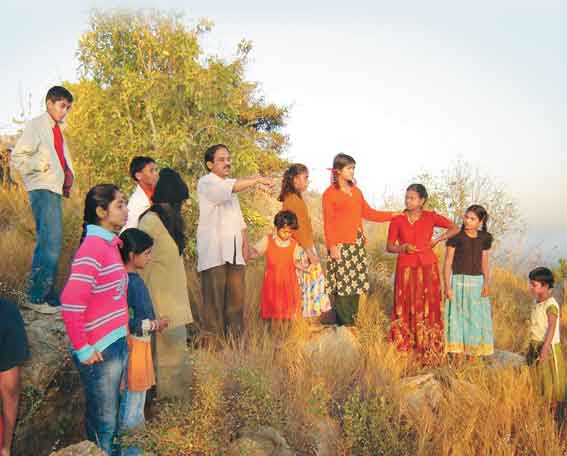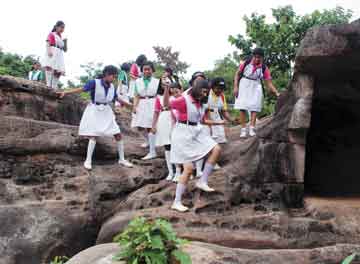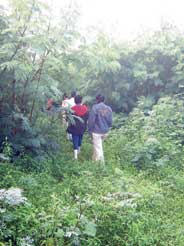Anna Neena George
Are there any reliable stewards of this blue planet, today?
Environmental, eco-friendly, green, etc., have become fashionable words. Makes you look very contemporary. It may not save this earth, though. That can happen only if the present generation takes stock of its actions. Today, every textbook, newspaper, magazine talks profusely about environmental problems in vivid details. However, this is a far cry from environment friendly living.

It sustains us. Do we care?
Schools are always busy with projects and programmes on environment, even though children have lost the awe of nature, the curiosity, and most of all respect for nature. Their life is far from the fields and farms. It is dominated by malls, supermarkets, TV shows, and virtual friends. Today’s children don’t even know where water comes from, even though their projects are filled with statistics about plants, animals, rivers around the world. It is no longer a knowledge/awareness problem, it is an attitude problem. ‘How will my action or inaction make a difference to this earth and my surroundings?’ This vital question is not addressed by any school/college exam or project.
The objective of teaching Environment Education (EE) in schools is to bring about an awareness, provide knowledge, build attitudes, develop skills, and encourage participation in nurturing our nature.
A cursory look at the objectives of EE will reveal what is amiss and why, in spite of so much of emphasis on EE and introducing it at all levels, the expected outcome is not seen. The reason being, like all subjects, EE too has become just another subject. The only objectives that got fulfilled are ‘knowledge’ and ‘awareness’. The development of attitudes, skills, and participation got submerged. Hence, we need to stop and think about how we can achieve the vital objectives of EE.
We have caused substantial deterioration of our environment and in turn of the quality of life. We have lost the rhythm of living in harmony with nature even though we know so much. It is imperative that we inculcate the right values and attitudes in the next generation to ensure a sustainable future. But how? More books, CDs, videos, TV shows? No. Lead the children outside the classroom. Go on nature trails, walks, and treks. The attitude to be a faithful steward of the earth will be inculcated only when they come in touch with nature.
The outdoors…
Bringing the children closer to nature will teach them to appreciate, understand, and protect nature. You could explore the outdoors by going on nature trails, treks, or camps. In this article we will talk about nature trails.
 What is a Nature trail?
What is a Nature trail?
- Usually a beaten path through a wild region. Done by foot, boat, animal back, bicycle, any eco-friendly transport. Distance may be 50 meters to a few kilometers.
- Remember in every natural place – mountain, wooded area, riverside, beach – there is much to be explored, recorded, communicated, and evaluated.
Planning the trail
While selecting a trail, ensure that you choose a theme, such as the river, birds, animals, rocks, insects, reptiles, or plants. Even a spider or an ant could give you a lot of opportunities for exploration and observation on a trail.
The place that you choose should have a bit of a rough terrain to put your fitness to the test, and should also be suitable for adventure, exploration and of course enjoyment. Avoid environmentally sensitive and fragile areas. The expert could be of help.
Organizing the trail
- Time your trail according to your theme. For example, if you are interested in frogs, ferns, fishes, migratory animals, which can be observed only in a particular season, then plan the trail accordingly.
- The trail shouldn’t be too long or too tough if you are going with small children. See that the trail is feasible for the target age group.
- Schedule for rest, breaks, water points, physical problems. The time to start the trail should be in accordance with the weather. Appropriate water points, breaks, rest, etc., should be planned in advance.
- Your route must have enough to keep the children interested and see that you don’t cause any destruction to the environment.
- Plan the route in such a way that it is a bit adventurous and gives more opportunities to observe. Crossing a tiny stream, negotiating climbs, rocky places make the trail interesting and challenging. It encourages cooperation and understanding of nature.
- The facilitator/expert must have good communication skills and technical knowledge,. A thorough knowledge of the place, its flora, fauna, its uniqueness, along with an interesting communication style makes the trail meaningful.
Trail tips
- The topography of the place should be taken into consideration while planning for the trail. The dress and footwear should be in accordance to both topography and weather.
- Check for necessary equipment. Binoculars, spotting scopes, cameras, video cameras, sound recorders are essential on a trail.
- Time required to cover the distance. The time required to cover the distance should be estimated taken into consideration rest and breaks.
- Special conditions on the trail. The spots of special attention on the trail like slippery place, infested place, presence of a particular plant or animal should be made clear to the group before the trail begins.
- Make sure that you leave the place as undisturbed as possible. Sufficient information about the plants both big and small, insects, reptiles, and others should be given during the briefing before the trail begins. The delicate interdependence and the harm that stamping or crushing can do to plants and small animals should be made known.
- Carry First aid supplies and plan what you may need to do/whom to call in an emergency. Also ensure that the group is protected from ticks, leeches, etc. You can use insect repellent sprays/ointments and wear appropriate clothing/footwear.
- Carry adequate food, water. Give proper instructions.
 Most important is to brief the group about the trail movement in groups, the time for breaks, use of observation checklist. Most important of all, not to make any kind of noise, rather speak softly. Record all observations as photos, drawings, and descriptions. Rather than going near the object, use binoculars. Use a sound recorder.
Most important is to brief the group about the trail movement in groups, the time for breaks, use of observation checklist. Most important of all, not to make any kind of noise, rather speak softly. Record all observations as photos, drawings, and descriptions. Rather than going near the object, use binoculars. Use a sound recorder.
While on the trail
Keep the group alert by asking, theme related questions during the breaks to get their responses and clear doubts.
- Practice conservation while walking the trail. Do not soil the trail. Avoid littering. Bring back your waste paper, plastic, etc.
- Avoid trampling over undisturbed spots. Use the beaten path.
- Keep observation checklist, books, reference materials at hand.
Ending the nature trail
The trail should not end abruptly. It should end with detailed discussions about the observations by different groups. Photos, videos taken could be shown. The observation checklists could be shared. Reference books, field guides should be used to explain the observations, and clear doubts. The experience should allow the group to relate theoretical information, prevalent environmental challenges with observations. Current local environmental problems may become more real and vivid.
Tomorrow’s Citizenry
Moulding a sensitized and responsible generation remains the aim of education. More specifically EE gears towards achieving the five objectives mentioned earlier. Unless the attitudes, skills, participation objectives are achieved, environmental problems will inflate. The Objectives of EE cannot be achieved by assimilation of vast knowledge only, rather by real life experiences of one’s surroundings. Nature trails, treks, camps are all beneficial to achieve the multipronged objectives of EE at all levels. Nature trails may sound very insignificant, but they can sow the seed for environmental conservation in young minds.
There is an urgent need for more individuals who are eager to find innovative solutions to perennial and irreversible problems the world is facing. We are moving towards the inevitable condition – an uninhabitable earth and severe scarcity of resources. Can we give this planet, our home, a chance to sustain life rather than head towards catastrophe?
The author is Associate Professor at GVM’s Dr. Dada Vaidya College of Education, Ponda, Goa. She can be reached at aneena2007@gmail.com.
